Global Research Trends in Sports Nutrition and Football over the Last 20 Years (2004–2024)
Abstract
1. Introduction
2. Materials and Methods
2.1. Data Collection
2.2. Scientometric Analysis
3. Results and Discussion
3.1. Temporal Trends in Publication and Authorship
3.2. Trends in Scientific Journals
3.3. Partnerships in the Scientific Field: Collaborative Networks Between Authors and Institutions
3.4. Scientific Output per Country
3.5. Structure and Trends of Themes in the Scientific Field
3.6. Study Limitations
4. Conclusions
Supplementary Materials
Author Contributions
Funding
Data Availability Statement
Acknowledgments
Conflicts of Interest
Abbreviations
| FIFA | International Federation of Association Football |
| WoS | Web of Science |
| n.d. | No Date |
| USP | University of São Paulo |
| UK | The United Kingdom |
References
- Nieman, D.C. Current and novel reviews in sports nutrition. Nutrients 2021, 13, 2549. [Google Scholar] [CrossRef]
- Kiss, A.; Temesi, A.; Tompa, O.; Lakner, Z.; Soós, S. Structure and trends of international sport nutrition research between 2000 and 2018: Bibliometric mapping of sport nutrition science. J. Int. Soc. Sports Nutr. 2021, 18, 12. [Google Scholar] [CrossRef]
- Holtzman, B.; Ackerman, K.E. Recommendations and nutritional considerations for female athletes: Health and performance. Sports Med. 2021, 51, 43–57. [Google Scholar] [CrossRef] [PubMed]
- Dobrowolski, H.; Karczemna, A.; Włodarek, D. Nutrition for female soccer players—Recommendations. Medicina 2020, 56, 28. [Google Scholar] [CrossRef]
- Santos, D.; Oliveira, D.M.; Franco, G. Aspectos fisiológicos e nutricionais aplicados ao futebol feminino. Rev. Bras. Futsal Futeb. 2019, 11, 279–290. Available online: https://www.rbff.com.br/index.php/rbff/article/view/731 (accessed on 13 July 2025).
- Bekris, E.; Pidoulas, G.; Pidoulas, P.; Gissis, I.; Katis, A.; Komsis, S. Examination of physical fitness parameters between professional and amateur Greek soccer players during the transition period. J. Strength Cond. Res. 2021, 35, 776–781. [Google Scholar] [CrossRef]
- Grabia, M.; Markiewicz-Śukowska, R.; Bielecka, J.; Puścion-Jakubik, A.; Socha, K. Effects of dietary intervention and education on selected biochemical parameters and nutritional habits of young soccer players. Nutrients 2022, 14, 3681. [Google Scholar] [CrossRef] [PubMed]
- Wu, Z.; Yin, T.T. Scientific research of FIFA World Cup and sports performance analysis advances: A bibliometric review study. Int. J. Acad. Res. Bus. Soc. Sci. 2023, 13, 466–474. [Google Scholar] [CrossRef]
- Liu, B.; Zhou, C.J.; Ma, H.W.; Gong, B. Mapping the youth soccer: A bibliometrix analysis using R-Tool. Digit. Health 2023, 9, 2–15. [Google Scholar] [CrossRef] [PubMed]
- Abdullah, K.H.; Sofyan, D.; Kamaruddin, H.K.; Osiobe, E.U. Sports and nutrition: A scientometric review. ASM Sci. J. 2024, 19, 1–15. [Google Scholar] [CrossRef]
- Tao, Y.; Wu, W. Research hotspots and trends in the relationship between sport and nutrition: A bibliometric analysis from 2013 to 2023. Medicine 2024, 103, e37782. [Google Scholar] [CrossRef]
- Kokol, P.; Vošner, H.B. Discrepancies among Scopus, Web of Science, and PubMed coverage of funding information in medical journal articles. J. Med. Libr. Assoc. 2018, 106, 81–86. [Google Scholar] [CrossRef]
- Nalimov, V.V.; Mulchenko, Z.M. Naukometriya. Izuchenie Razvitiya Nauki kak Informatsionnogo Protsessa; Nauka: Moscow, Russia, 1969. [Google Scholar]
- Aria, M.; Cuccurullo, C. Bibliometrix: An R-tool for comprehensive science mapping analysis. J. Informetr. 2017, 11, 959–975. [Google Scholar] [CrossRef]
- Page, M.J.; McKenzie, J.E.; Bossuyt, P.M.; Boutron, I.; Hoffmann, T.C.; Mulrow, C.D.; Shamseer, L.; Tetzlaff, J.M.; Akl, E.A.; Brennan, S.E.; et al. A Declaração PRISMA 2020: Diretriz atualizada para relatar revisões sistemáticas. Rev. Panam. Salud Publica 2022, 46, e112. [Google Scholar] [CrossRef]
- Bradford, S.C. Sources of information on specific subjects. Engineering 1934, 137, 85–86. [Google Scholar]
- Van Eck, N.; Waltman, L. Software survey: VOSviewer, a computer program for bibliometric mapping. Scientometrics 2010, 84, 523–538. [Google Scholar] [CrossRef] [PubMed]
- Arumugam, N.; Anuar, N.; Selvanayagam, S.; Sathiyasenan, S.D. The impact of COVID-19 on the sport industry. Int. J. Acad. Res. Bus. Soc. Sci. 2021, 11, 397–411. [Google Scholar] [CrossRef]
- Kirkendall, D.T.; Leiper, J.B.; Bartagi, Z.; Dvorak, J.; Zerguini, Y. The influence of Ramadan on physical performance measures in young Muslim footballers. J. Sports Sci. 2008, 26, 15–27. [Google Scholar] [CrossRef]
- Leiper, J.B.; Maughan, R.J.; Kirkendall, D.T.; Bartagi, Z.; Zerguini, Y.; Junge, A.; Dvorak, J. The F-MARC Study on Ramadan and football: Research design, population, and environmental conditions. J. Sports Sci. 2008, 26, 7–13. [Google Scholar] [CrossRef]
- Maugham, R.J.; Shirreffs, S.M.; Merson, S.J.; Horswill, C.A. Fluid and electrolyte balance in elite male football (soccer) players training in a cool environment. J. Sports Sci. 2005, 23, 73–79. [Google Scholar] [CrossRef] [PubMed]
- Zerguini, Y.; Dvorak, J.; Maughan, R.J.; Leiper, J.B.; Bartagi, Z.; Kirkendall, D.T.; Al-Riyami, M.; Junge, A. Influence of Ramadan fasting on physiological and performance variables in football players: Summary of the F-MARC 2006 Ramadan Fasting Study. J. Sports Sci. 2008, 26, 3–6. [Google Scholar] [CrossRef]
- Kurdak, S.S.; Shirreffs, S.M.; Maughan, R.J.; Ozgünen, K.T.; Zeren, Ç.; Korkmaz, S.; Yazici, Z.; Ersöz, G.; Binnet, M.S.; Dvorak, J. Hydration and sweating responses to hot-weather football competition. Scand. J. Med. Sci. Sports 2010, 20, 133–139. [Google Scholar] [CrossRef] [PubMed]
- Nutrients. About the Journal. Available online: https://www.mdpi.com/journal/nutrients (accessed on 23 April 2025).
- Clarivate. Journal Citation Reports. Available online: https://clarivate.com/blog/tag/journal-citation-reports/ (accessed on 23 April 2025).
- Schmidt, M. The Sankey Diagram in energy and material flow management. J. Ind. Ecol. 2008, 12, 173–185. [Google Scholar] [CrossRef]
- Journal of Sports Sciences. About the Journal. Available online: https://www.tandfonline.com/journals/rjsp20 (accessed on 23 April 2025).
- Revista Brasileira de Nutrição Esportiva. Sobre a Revista. Available online: https://www.rbne.com.br/index.php/rbne (accessed on 23 April 2025).
- Clarivate. Web of Science. Available online: https://www.webofscience.com (accessed on 23 April 2025).
- Edwards, A.M.; Mann, M.E.; Marfell-Jones, M.J.; Rankin, D.M.; Noakes, T.D.; Shillington, D.P. Influence of moderate dehydration on soccer performance: Physiological responses to 45 min of outdoor match-play and the immediate subsequent performance of sport-specific and mental concentration tests. Br. J. Sports Med. 2007, 41, 385–391. [Google Scholar] [CrossRef] [PubMed]
- Shirreffs, S.M.; Aragon-Vargas, L.F.; Chamorro, M.; Maughan, R.J.; Serratosa, L.; Zachwieja, J.J. The sweating response of elite professional soccer players to training in the heat. Int. J. Sports Med. 2005, 26, 90–95. [Google Scholar] [CrossRef]
- Ali, A.; Williams, C.; Nicholas, C.W.; Foskett, A. The influence of carbohydrate-electrolyte ingestion on soccer skill performance. Med. Sci. Sports Exerc. 2007, 39, 1969–1976. [Google Scholar] [CrossRef] [PubMed]
- Tscholl, P.; Junge, A.; Dvorak, J. The use of medication and nutritional supplements during FIFA World Cups 2002 and 2006. Br. J. Sports Med. 2008, 42, 725–730. [Google Scholar] [CrossRef]
- Maughan, R.J.; Leiper, J.B.; Bartagi, Z.; Zrifi, R.; Zerguini, Y.; Dvorak, J. Effect of Ramadan fasting on some biochemical and haematological parameters in Tunisian youth soccer players undertaking their usual training and competition schedule. J. Sports Sci. 2008, 26, 39–46. [Google Scholar] [CrossRef]
- Hoffman, J.R.; Ratamess, N.A.; Faigenbaum, A.D.; Ross, R.; Kang, J.; Stout, J.R.; Wise, J.A. Short-duration beta-alanine supplementation increases training volume and reduces subjective feelings of fatigue in college football players. Nutr. Res. 2008, 28, 31–35. [Google Scholar] [CrossRef]
- Anderson, L.; Orme, P.; Naughton, R.J.; Close, G.L.; Milsom, J.; Rydings, D.; O’Boyle, A.; Di Michele, R.; Louis, J.; Hambley, C.; et al. Energy intake and expenditure of professional soccer players of the English Premier League: Evidence of carbohydrate periodization. Int. J. Sport Nutr. Exerc. Metab. 2017, 27, 228–238. [Google Scholar] [CrossRef]
- Micheli, M.L.; Pagani, L.; Marella, M.; Gulisano, M.; Piccoli, A.; Angelini, F.; Burtscher, M.; Gatterer, H. Bioimpedance and impedance vector patterns as predictors of league level in male soccer players. Int. J. Sports Physiol. Perform. 2014, 9, 532–539. [Google Scholar] [CrossRef]
- Devlin, B.L.; Leveritt, M.D.; Kingsley, M.; Belski, R. Dietary intake, body composition, and nutrition knowledge of Australian football and soccer players: Implications for sports nutrition professionals in practice. Int. J. Sport Nutr. Exerc. Metab. 2017, 27, 130–138. [Google Scholar] [CrossRef]
- Bandelow, S.; Maughan, R.; Shirreffs, S.; Ozgünen, K.; Kurdak, S.; Ersöz, G.; Binnet, M.; Dvorak, J. The effects of exercise, heat, cooling and rehydration strategies on cognitive function in football players. Scand. J. Med. Sci. Sports 2010, 20 (Suppl. S3), 148–160. [Google Scholar] [CrossRef]
- Katz, J.S.; Martin, B.R. What is research collaboration? Res. Policy 1997, 26, 1–18. [Google Scholar] [CrossRef]
- Foo, W.L.; Tester, E.; Close, G.L.; Cronin, C.J.; Morton, J.P. Professional male soccer players’ perspectives of the nutrition culture within an English Premier League football club: A qualitative exploration using Bourdieu’s concepts of habitus, capital and field. Sports Med. 2024, 55, 1009–1022. [Google Scholar] [CrossRef] [PubMed]
- Coimbra, D.R.; Dominski, F.H.; Correia, C.K.; Andrade, A. Scientific production in sports science journals: Bibliometric analysis. Rev. Bras. Med. Esporte 2019, 25, 88–93. [Google Scholar] [CrossRef]
- Sanmiguel-Rodríguez, A.; Gonzalez-Villora, S.; Arufe-Giraldez, V. High-performance football in Spain: Systematic review (2015–2019). J. Hum. Sport Exerc. 2021, 17, 942–957. [Google Scholar] [CrossRef]
- Cullen, M.; Batt, M. Sport and exercise medicine in the United Kingdom comes of age. Br. J. Sports Med. 2005, 39, 250–251. [Google Scholar] [CrossRef] [PubMed]
- Fullagar, H.H.K.; McCall, A.; Impellizzeri, F.M.; Favero, T.; Coutts, A.J. The translation of sport science research to the field: A Current opinion and overview on the perceptions of practitioners, researchers and coaches. Sports Med. 2019, 49, 1817–1824. [Google Scholar] [CrossRef]
- Siegler, J.C.; Mermier, C.M.; Amorim, F.T.; Lovell, R.J.; McNaughton, L.R.; Robergs, R.A. Hydration, thermoregulation, and performance effects of two sport drinks during soccer training sessions. J. Strength Cond. Res. 2008, 22, 1394–1401. [Google Scholar] [CrossRef][Green Version]
- Guttierres, A.P.M.; Natali, A.J.; Alfenas, R.C.G.; Marins, J.C.B. Ergogenic effect of a caffeinated sports drink on performance in soccer specific abilities tests. Rev. Bras. Med. Esporte 2009, 15, 450–454. [Google Scholar] [CrossRef]
- Al-Jaser, T.A.; Hasan, A.A. Fluid loss and body composition of elite Kuwaiti soccer players during a soccer match. J. Sports Med. Phys. Fit. 2006, 46, 281–285. [Google Scholar]
- Aragón-Vargas, L.F.; Moncada-Jiménez, J.; Hernández-Elizondo, J.; Barrenechea, A.; Monge-Alvarado, M. Evaluation of pre-game hydration status, heat stress, and fluid balance during professional soccer competition in the heat. Eur. J. Sport Sci. 2009, 9, 269–276. [Google Scholar] [CrossRef]
- Chapelle, L.; Tassignon, B.; Aerenhouts, D.; Mullie, P.; Clarys, P. The hydration status of young female elite soccer players during an official tournament. J. Sports Med. Phys. Fit. 2017, 57, 1186–1194. [Google Scholar] [CrossRef]
- Briggs, M.; Rumbold, P.; Cockburn, E.; Russell, M.; Stevenson, E. Agreement between two methods of dietary data collection in male adolescent academy-level soccer players. Nutrients 2015, 7, 5948–5960. [Google Scholar] [CrossRef] [PubMed]
- Naclerio, F.; Larumbe-Zabala, E.; Cooper, R.; Allgrove, J.; Earnest, C.P. A multi-ingredient containing carbohydrate, proteins L-glutamine and L-carnitine attenuates fatigue perception with no effect on performance, muscle damage or immunity in soccer players. PLoS ONE 2015, 10, e0125188. [Google Scholar] [CrossRef]
- Nyakayiru, J.; Jonvik, K.L.; Trommelen, J.; Pinckaers, P.J.M.; Senden, J.M.; Van Loon, L.J.C.; Verdijk, L.B. Beetroot juice supplementation improves high-intensity intermittent type exercise performance in trained soccer players. Nutrients 2017, 9, 314. [Google Scholar] [CrossRef]
- Baralic, I.; Djordjevic, B.; Dikic, N.; Kotur-Stevuljevic, J.; Spasic, S.; Jelic-Ivanovic, Z.; Radivojevic, N.; Andjelkovic, M.; Pejic, S. Effect of Astaxanthin supplementation on paraoxonase 1 activities and oxidative stress status in young soccer players. Phytother. Res. 2013, 27, 1536–1542. [Google Scholar] [CrossRef]
- Manzano-Carrasco, S.; Felipe, J.L.; Sanchez-Sanchez, J.; Hernandez-Martin, A.; Gallardo, L.; Garcia-Unanue, J. Physical fitness, body composition, and adherence to the Mediterranean diet in young football players: Influence of the 20 mSRT score and maturational stage. Int. J. Environ. Res. Public Health 2020, 17, 3257. [Google Scholar] [CrossRef]
- Ferrari, D.; Lombardi, G.; Strollo, M.; Pontillo, M.; Motta, A.; Locatelli, M. A possible antioxidant role for vitamin d in soccer players: A retrospective analysis of psychophysical stress markers in a professional team. Int. J. Environ. Res. Public Health 2020, 17, 3484. [Google Scholar] [CrossRef]
- Kotsis, Y.; Mikellidi, A.; Aresti, C.; Persia, E.; Sotiropoulos, A.; Panagiotakos, D.B.; Antonopoulou, S.; Nomikos, T. A low-dose, 6-week bovine colostrum supplementation maintains performance and attenuates inflammatory indices following a Loughborough Intermittent Shuttle Test in soccer players. Eur. J. Nutr. 2018, 57, 1181–1195. [Google Scholar] [CrossRef]
- Frazer, R.; Bowler, A.L.; Condo, D.; Cox, G.; Pelly, F.; Slater, G. Commonly used indicators of low energy availability risk fail to identify female amateur soccer players with measured low energy availability during preseason. Int. J. Sport Nutr. Exerc. Metab. 2024, 34, 387–396. [Google Scholar] [CrossRef]
- Atan, R.M.; Ersoy, G.; Çakıcı, Ç. Effects of hardaliye, a fermented grape drink, on oxidative stress, lipid profile, and blood pressure in young soccer players: A randomized controlled trial. J. Am. Nutr. Assoc. 2024, 43, 356–364. [Google Scholar] [CrossRef] [PubMed]
- Moss, S.L.; Randell, R.K.; Burgess, D.; Ridley, S.; Ócairealláin, C.; Allison, R.; Rollo, I. Assessment of energy availability and associated risk factors in professional female soccer players. Eur. J. Sport Sci. 2020, 21, 861–870. [Google Scholar] [CrossRef]
- Rosenvinge, J.H.; Dasa, M.S.; Kristoffersen, M.; Pettersen, G.; Sundgot-Borgen, J.; Sagen, J.V.; Friborg, O. Study protocol: Prevalence of low energy availability and its relation to health and performance among female football players. BMJ Open Sport Exerc. Med. 2022, 8, e001219. [Google Scholar] [CrossRef]
- Rosid, A.; Khomsan, A.; Setiawan, B.; Riyadi, H.; Briawan, D. Effect of temulawak (Curcumin xanthorrhiza Roxb) extract on reduction of MDA (Malondialdehyde) levels of football athletes. Pak. J. Nutr. 2013, 12, 842–850. [Google Scholar] [CrossRef]
- Quero, C.D.; Manonelles, P.; Fernández, M.; Abellán-Aynés, O.; López-Plaza, D.; Andreu-Caravaca, L.; Hinchado, M.D.; Gálvez, I.; Ortega, E. Differential health effects on inflammatory, immunological and stress parameters in professional soccer players and sedentary individuals after consuming a synbiotic. A triple-blinded, randomized, placebo-controlled pilot study. Nutrients 2021, 13, 1321. [Google Scholar] [CrossRef] [PubMed]
- Rosas, F.; Ramírez-Campillo, R.; Martínez, C.; Caniuqueo, A.; Cañas-Jamet, R.; McCrudden, E.; Meylan, C.; Moran, J.; Nakamura, F.Y.; Pereira, L.A.; et al. Effects of plyometric training and beta-alanine supplementation on maximal-intensity exercise and endurance in female soccer players. J. Hum. Kinet. 2017, 58, 99–109. [Google Scholar] [CrossRef] [PubMed]
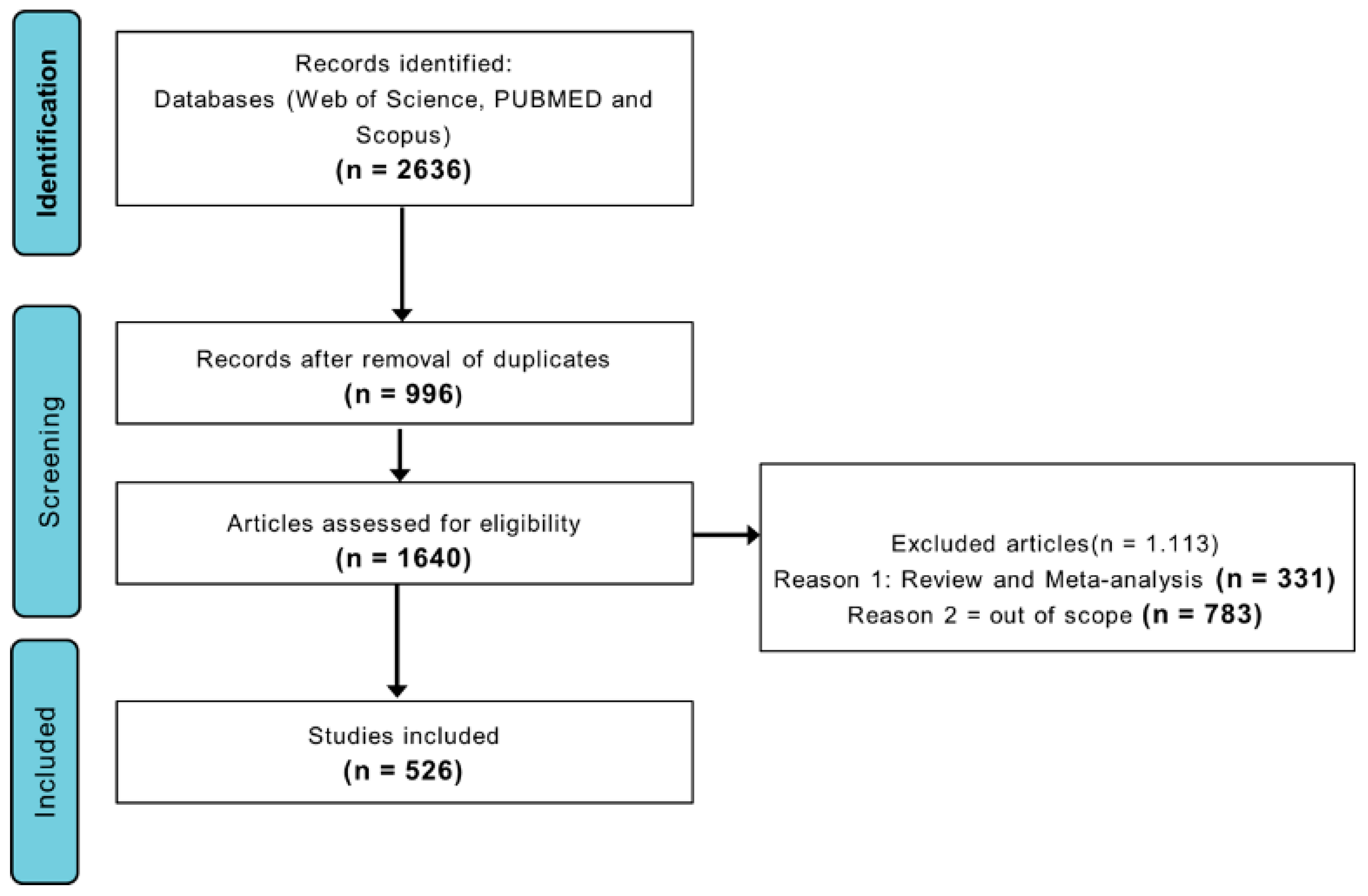
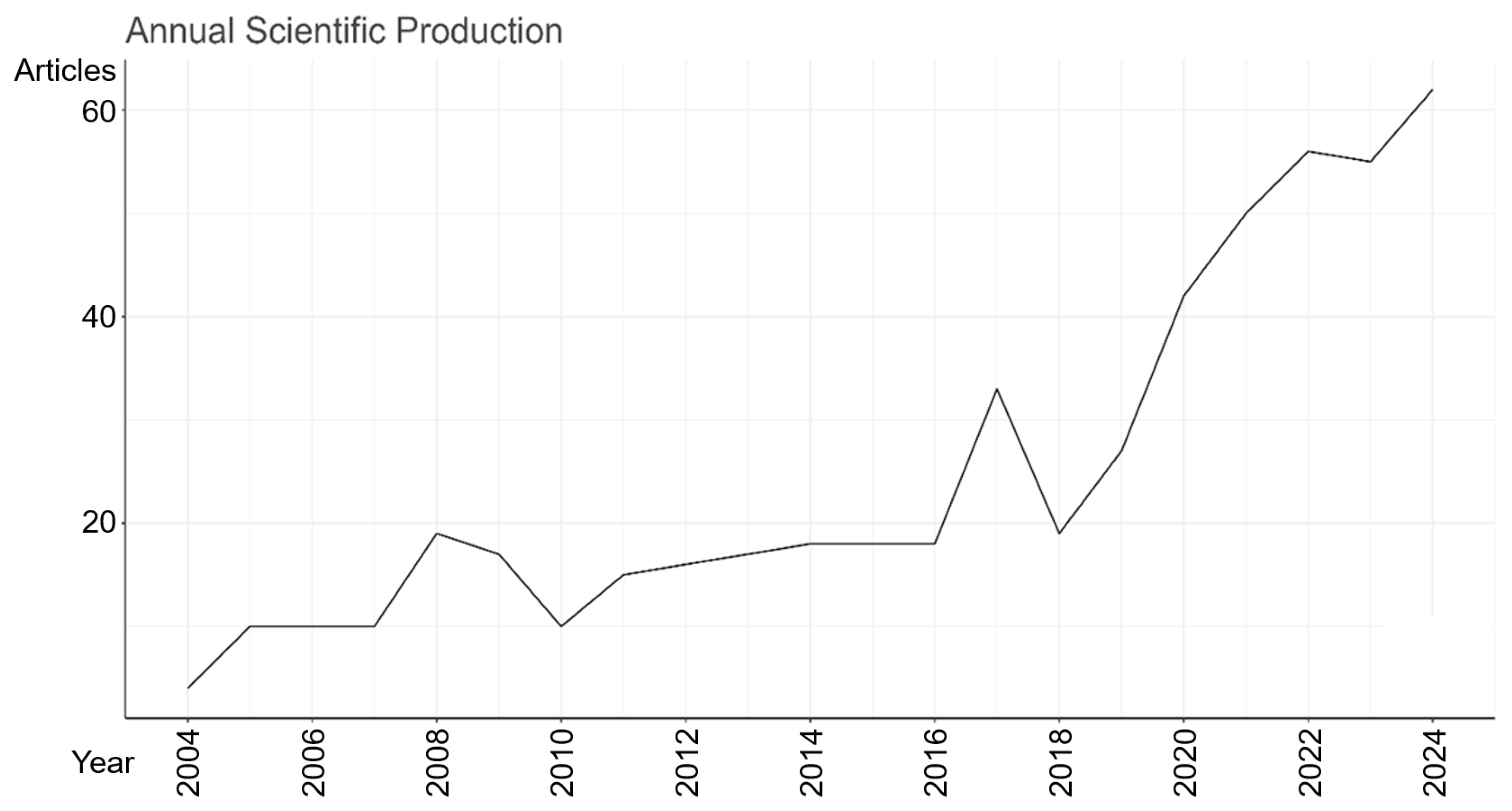
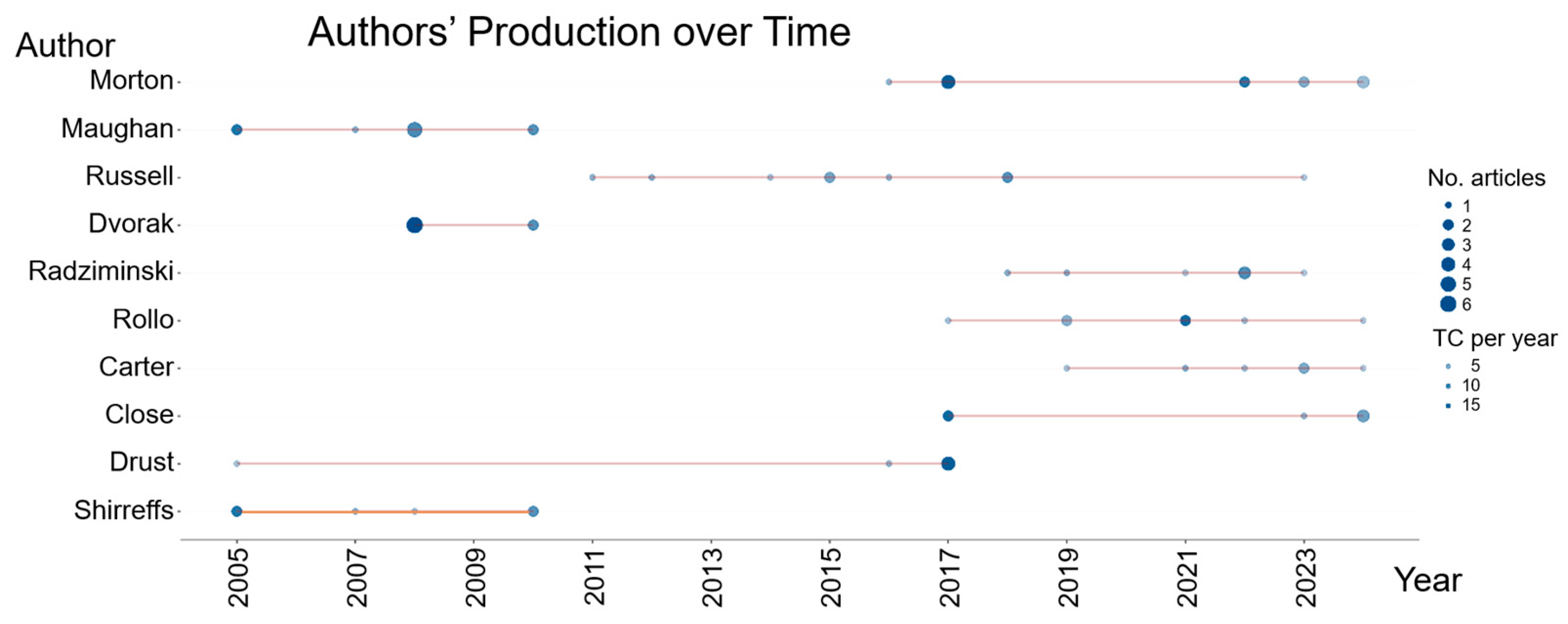
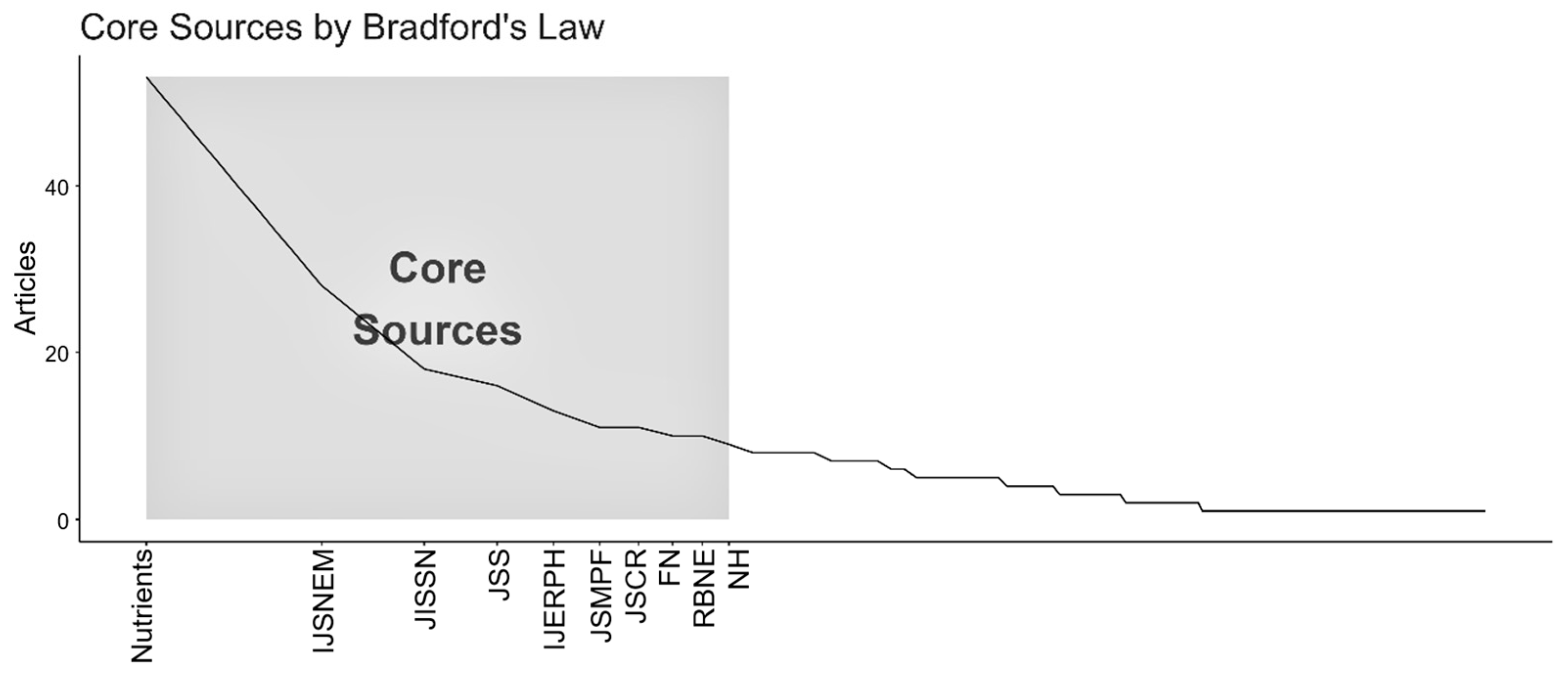
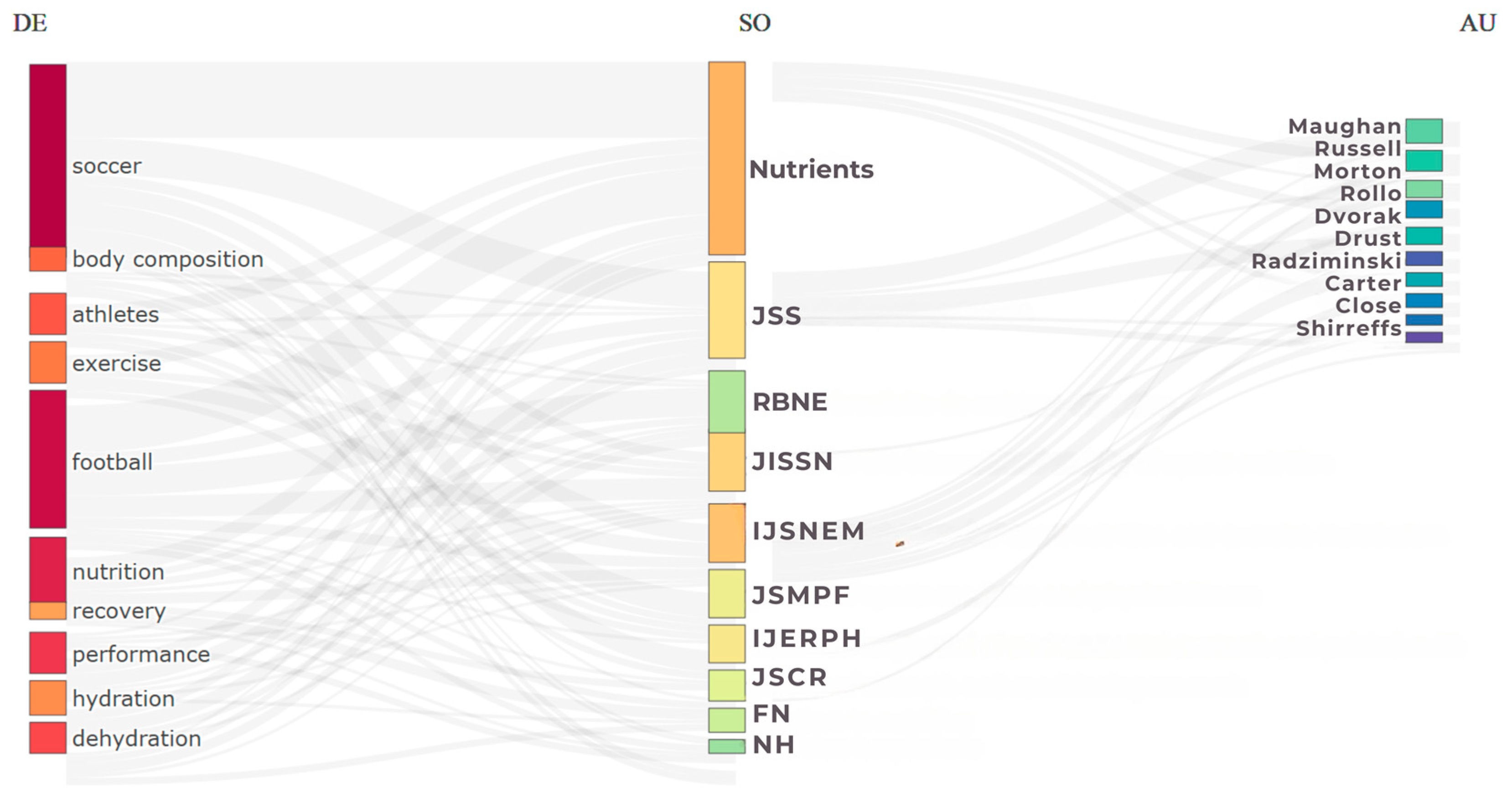
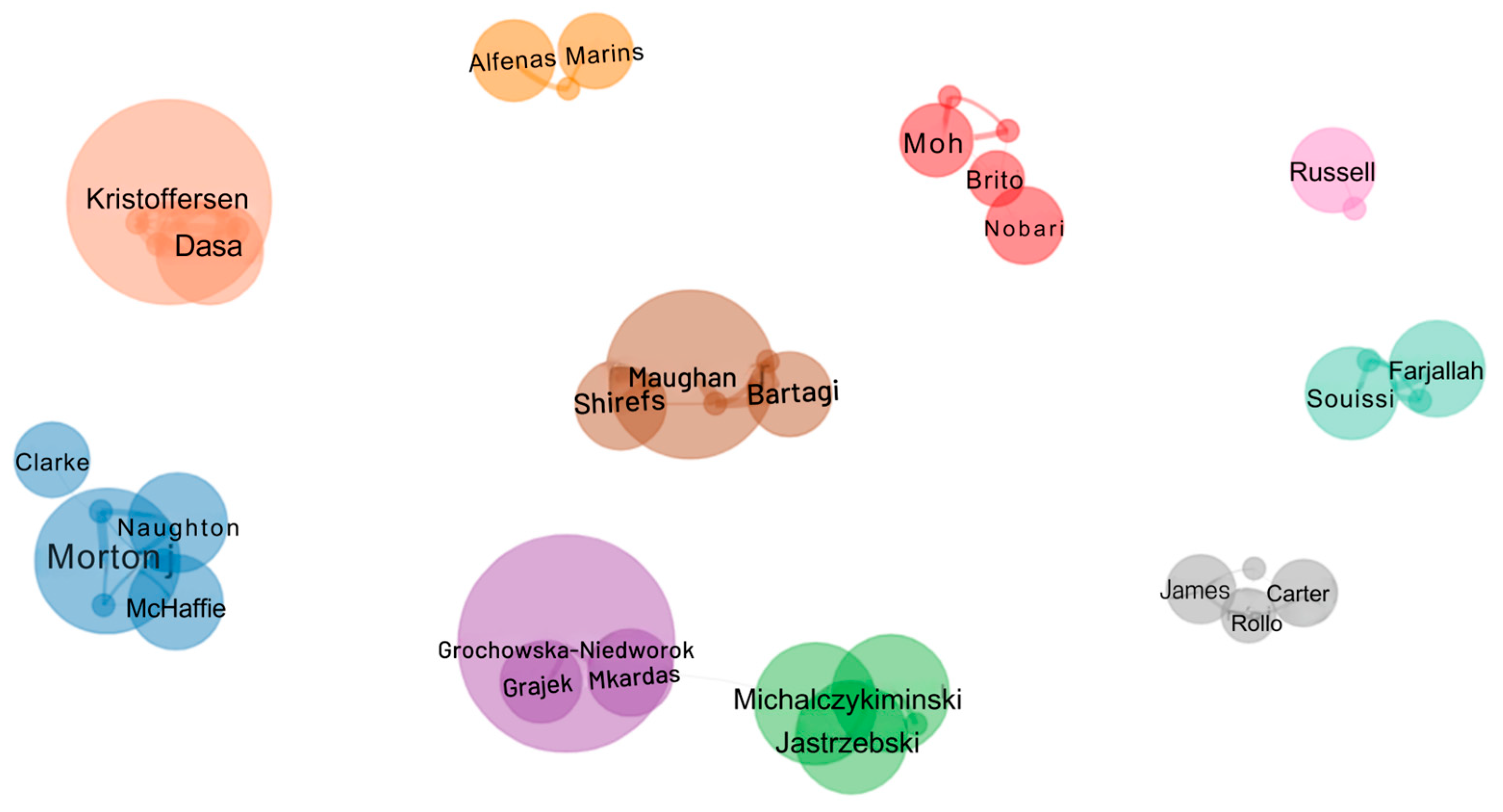
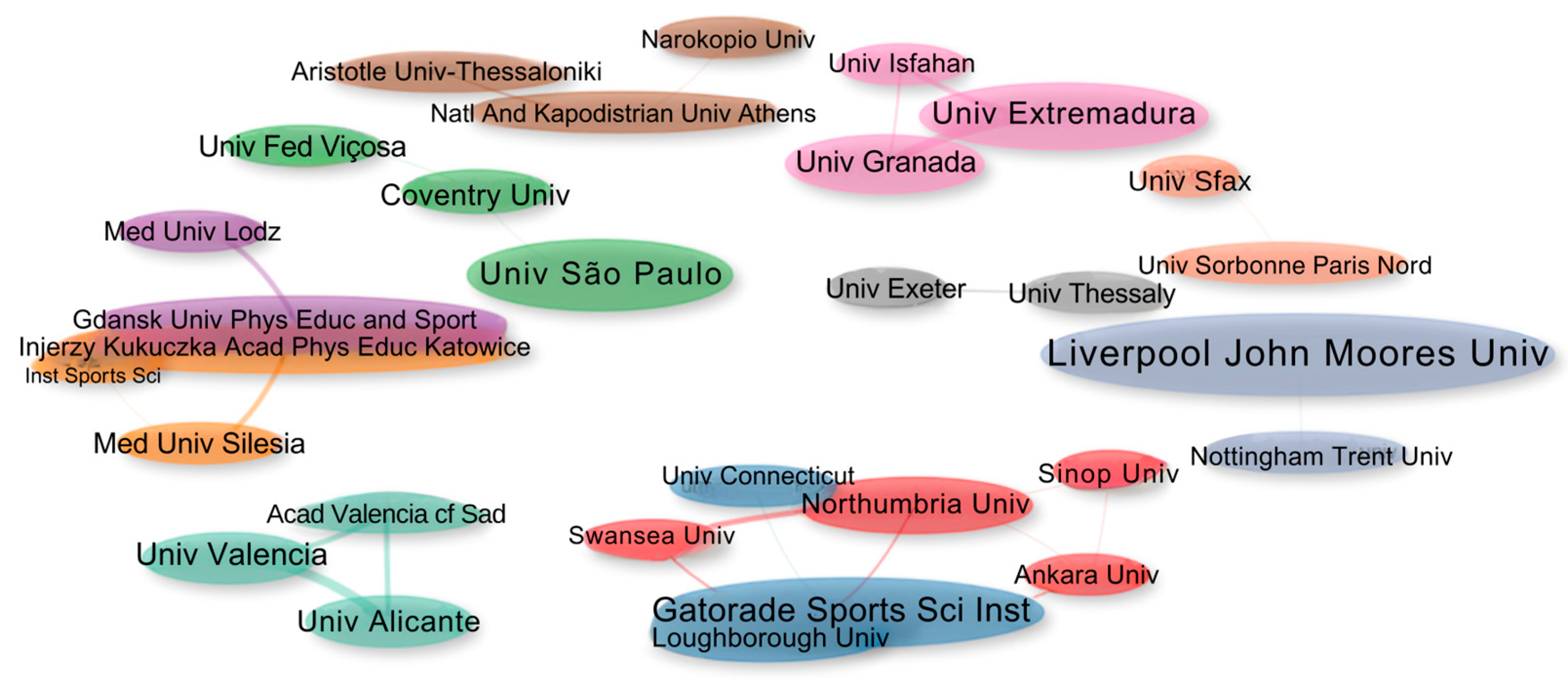
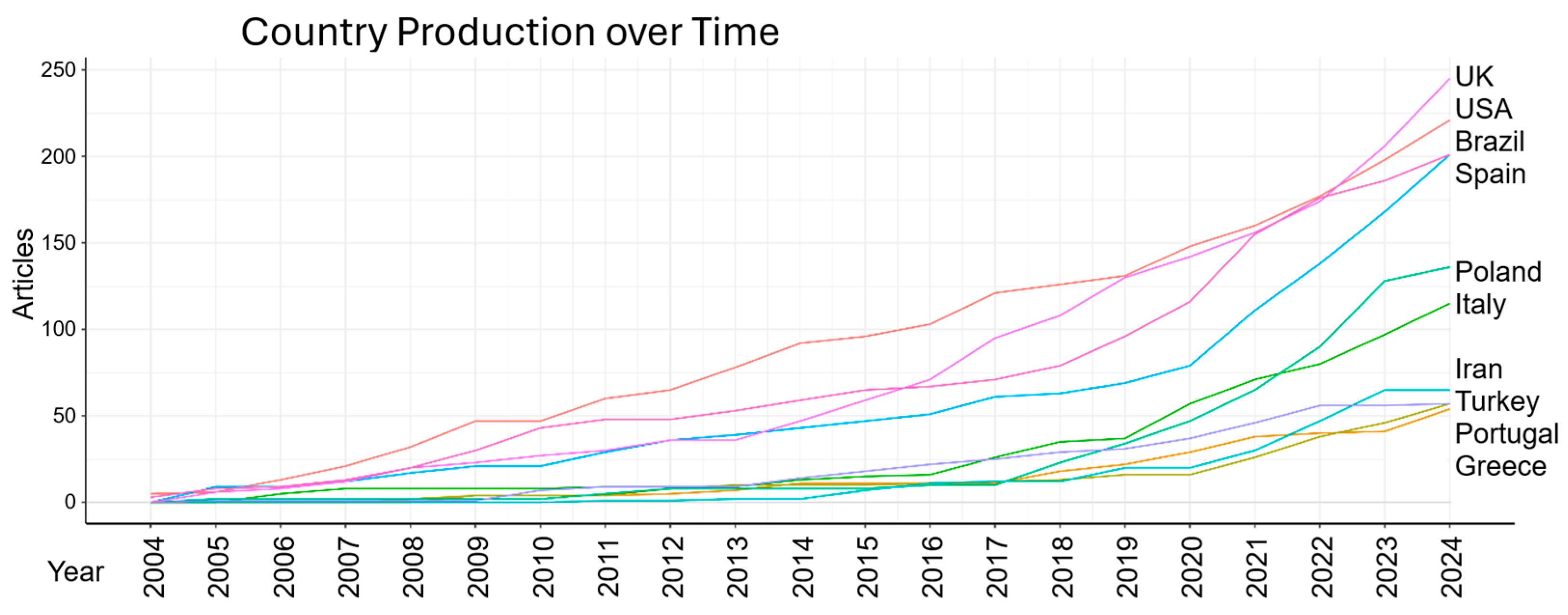
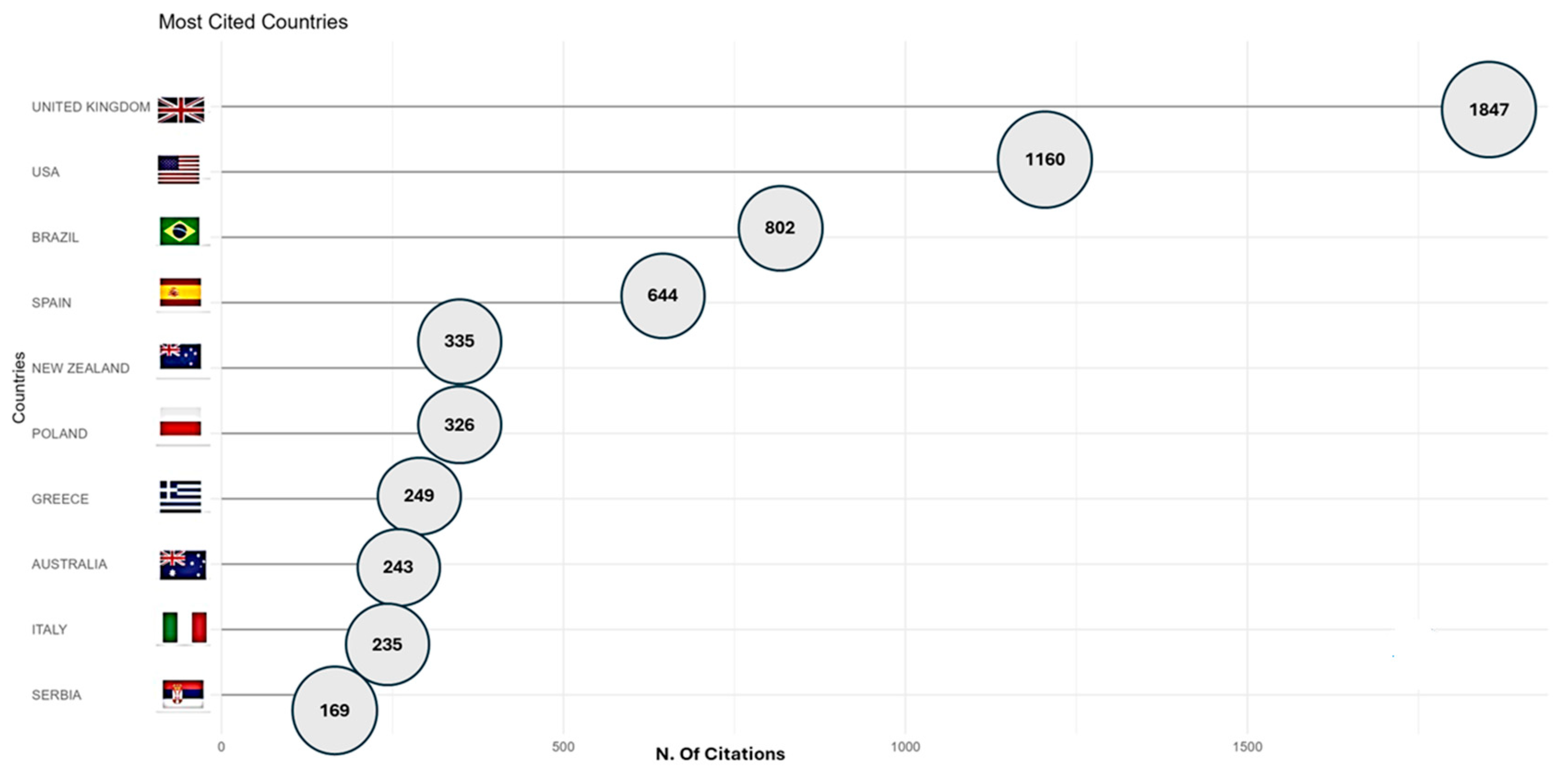
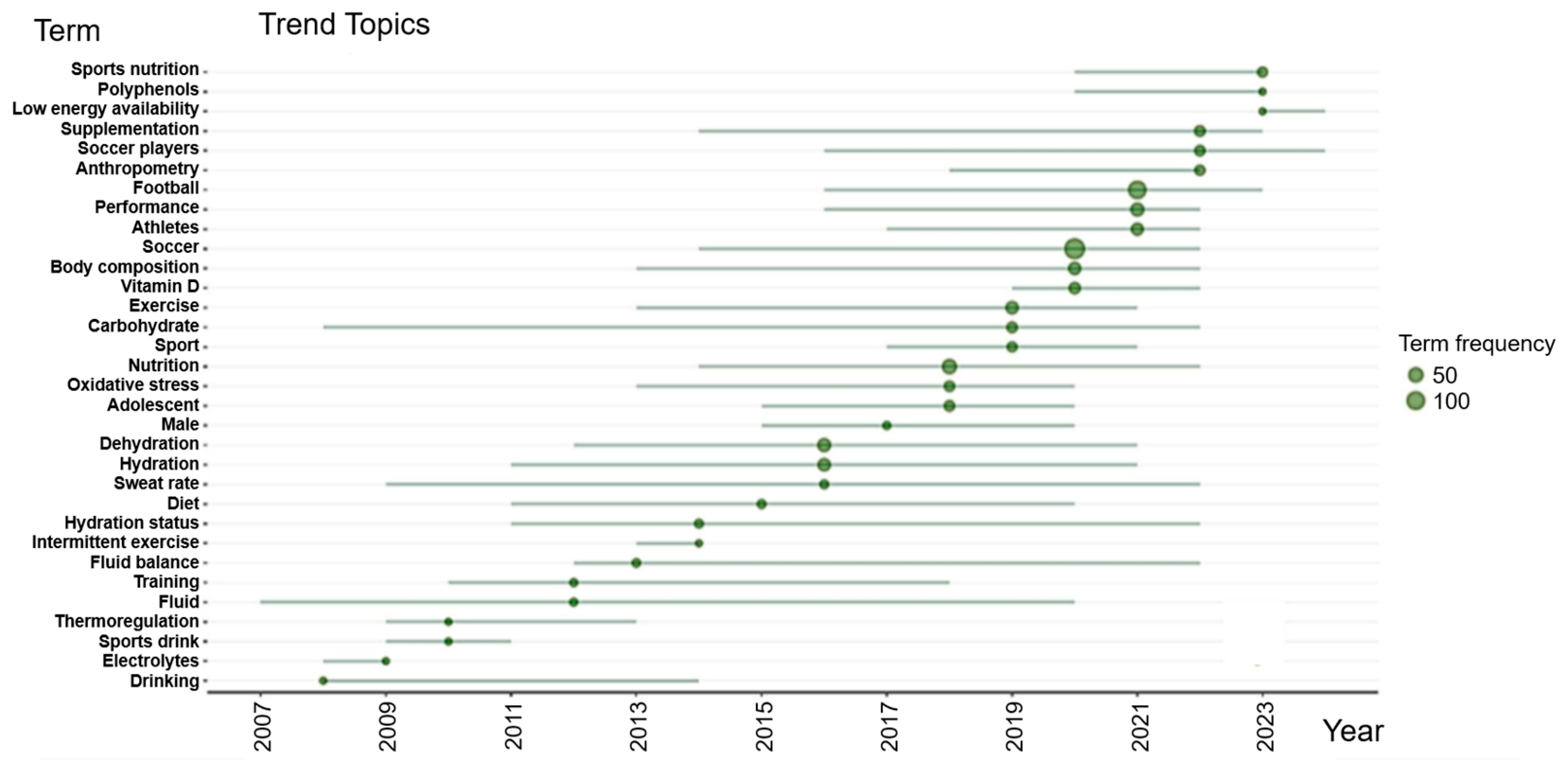
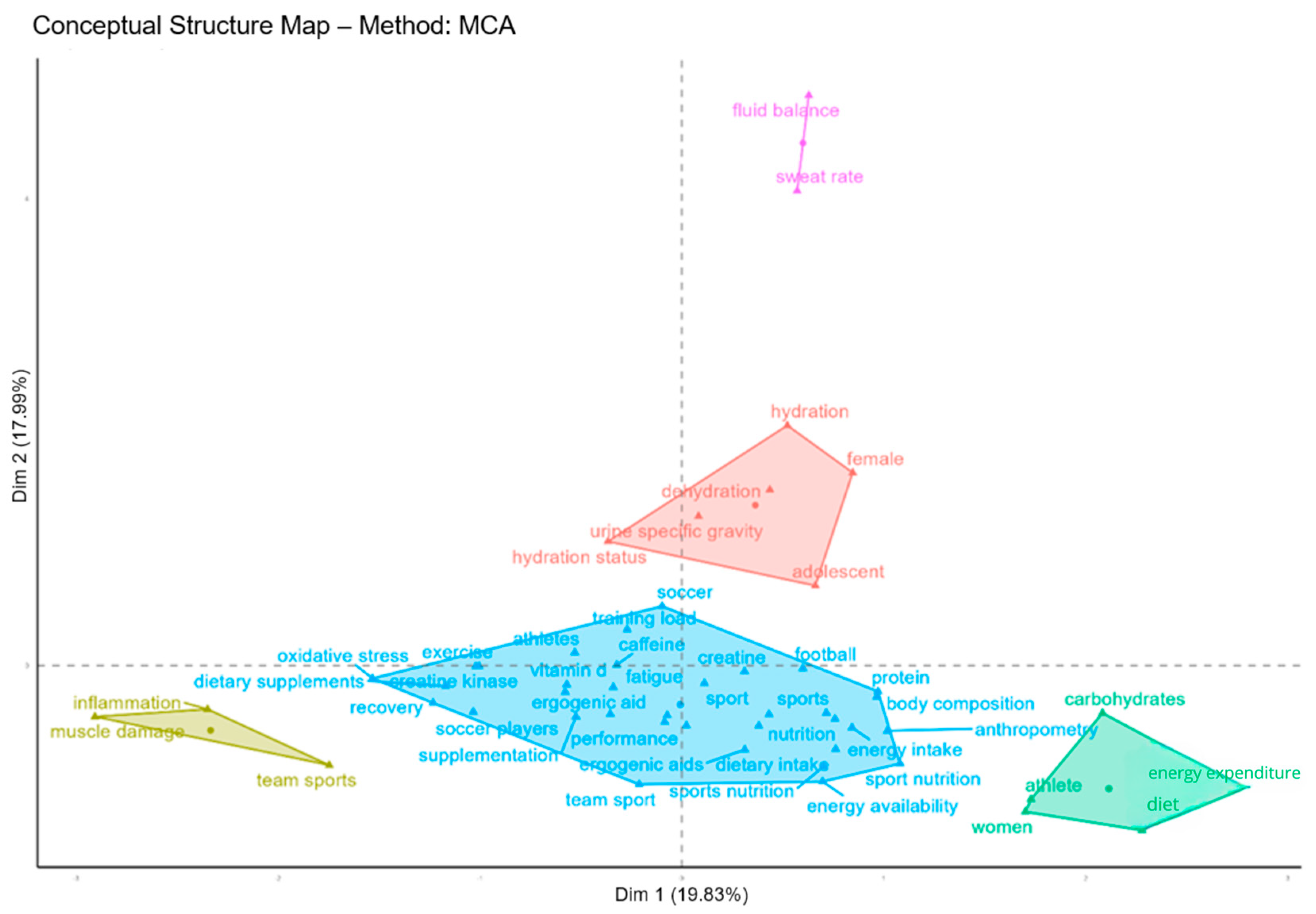
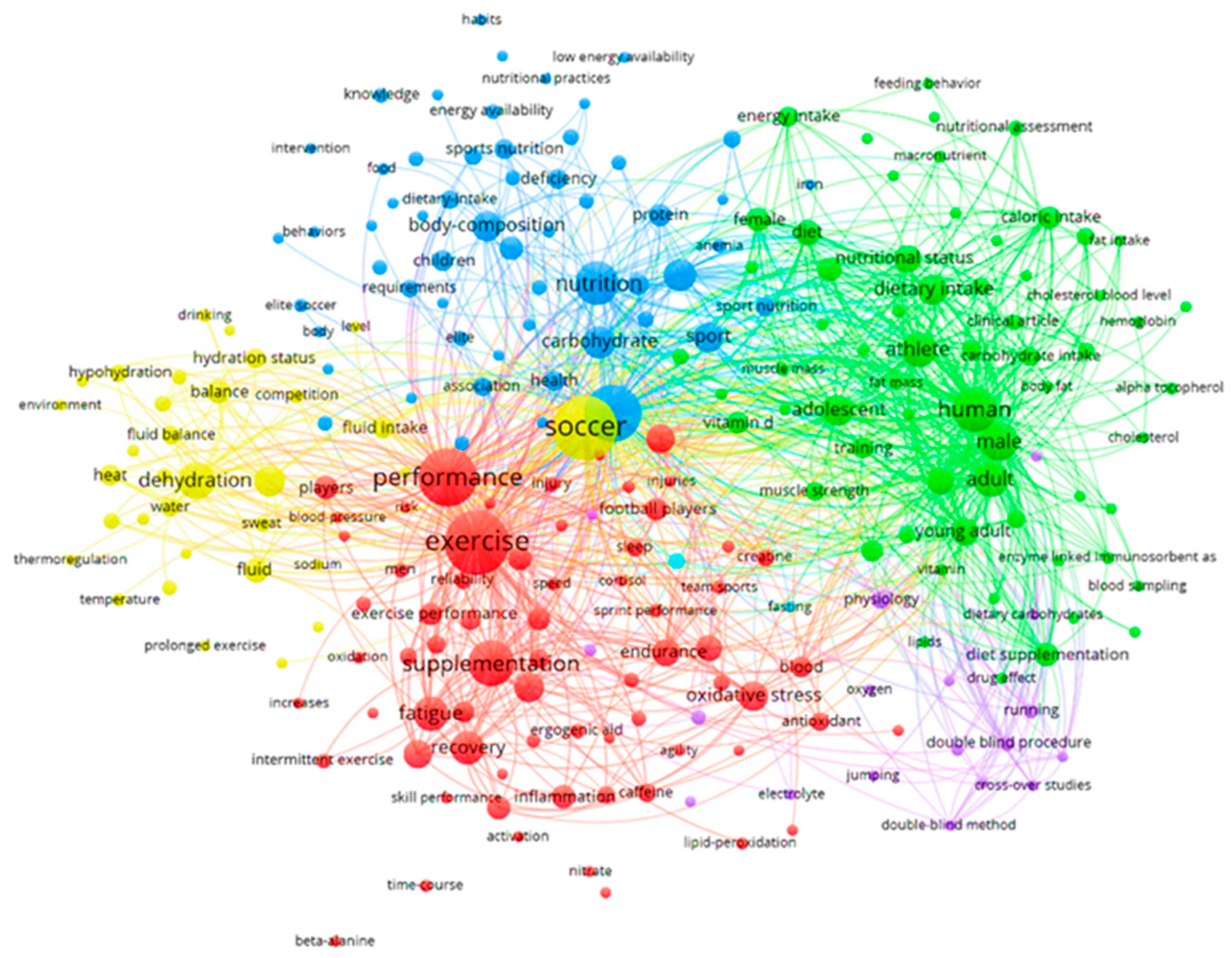
| Journal | No. of Articles | % of Total | IF (JCR 2023) |
|---|---|---|---|
| 1st Nutrients | 53 | 29.6% | 4.8 |
| 2nd International Journal of Sport Nutrition and Exercise Metabolism | 28 | 15.6% | 4.6 |
| 3rd Journal of the International Society of Sports Nutrition | 18 | 10.1% | 3.0 |
| 4th Journal of Sports Sciences | 16 | 8.9% | 2.8 |
| 5th *International Journal of Environmental Research and Public Health | 13 | 7.3% | 1.4 |
| 6th Journal of Sports Medicine and Physical Fitness | 11 | 6.1% | 1.2 |
| 7th Journal of Strength and Conditioning Research | 11 | 6.1% | 2.0 |
| 8th Frontiers in Nutrition | 10 | 5.6% | 6.0 |
| 9th Revista Brasileira de Nutrição Esportiva | 10 | 5.6% | 0.2 |
| 10th Nutrición Hospitalaria | 9 | 5.0% | 1.5 |
| Ranking/Author/Year | Source | TC | TC per Year |
|---|---|---|---|
| 1st Edwards A, 2007 [30] | British Journal of Sports Medicine | 161 | 8.47 |
| 2nd Shirreffs S, 2005 [31] | International Journal of Sports Medicine | 147 | 7.00 |
| 3rd Ali A, 2007 [32] | Medicine and Science in Sports and Exercise | 119 | 6.26 |
| 4th Tscholl P, 2008 [33] | British Journal of Sports Medicine | 114 | 6.33 |
| 5th Maughan R, 2005 [34] | Journal of Sports Sciences | 112 | 5.33 |
| 6th Hoffman J, 2008 [35] | Nutrition Research | 105 | 5.83 |
| 7th Anderson L, 2017 [36] | International Journal of Sport Nutrition and Exercise Metabolism | 101 | 11.22 |
| 8th Micheli M, 2014 [37] | International Journal of Sports Physiology and Performance | 87 | 7.25 |
| 9th Devlin B, 2017 [38] | International Journal of Sport Nutrition and Exercise Metabolism | 84 | 9.33 |
| 10th Bandelow S, 2010 [39] | Scandinavian Journal of Medicine & Science in Sports | 83 | 5.19 |
| Ranking | Country | Number of Articles | Percentage of Total Production |
|---|---|---|---|
| 1 | United Kingdom | 245 | 46.6% |
| 2 | Brazil | 221 | 42.0% |
| 3 | Spain | 201 | 38.2% |
| 4 | Usa | 201 | 38.2% |
| 5 | Poland | 136 | 25.9% |
| 6 | Italy | 115 | 21.9% |
| 7 | Portugal | 65 | 12.4% |
| 8 | Iran | 57 | 10.8% |
| 9 | Turkey | 57 | 10.8% |
| 10 | Greece | 54 | 10.3% |
Disclaimer/Publisher’s Note: The statements, opinions and data contained in all publications are solely those of the individual author(s) and contributor(s) and not of MDPI and/or the editor(s). MDPI and/or the editor(s) disclaim responsibility for any injury to people or property resulting from any ideas, methods, instructions or products referred to in the content. |
© 2025 by the authors. Licensee MDPI, Basel, Switzerland. This article is an open access article distributed under the terms and conditions of the Creative Commons Attribution (CC BY) license (https://creativecommons.org/licenses/by/4.0/).
Share and Cite
de Oliveira, D.M.; Silva, A.K.A.C.; Macedo, A.G.; Fernandes, M.B.; Fernandes, E.V. Global Research Trends in Sports Nutrition and Football over the Last 20 Years (2004–2024). Sports 2025, 13, 365. https://doi.org/10.3390/sports13100365
de Oliveira DM, Silva AKAC, Macedo AG, Fernandes MB, Fernandes EV. Global Research Trends in Sports Nutrition and Football over the Last 20 Years (2004–2024). Sports. 2025; 13(10):365. https://doi.org/10.3390/sports13100365
Chicago/Turabian Stylede Oliveira, David Michel, Ana Karolina Assis Carvalho Silva, Anderson Geremias Macedo, Mayara Bocchi Fernandes, and Eduardo Vignoto Fernandes. 2025. "Global Research Trends in Sports Nutrition and Football over the Last 20 Years (2004–2024)" Sports 13, no. 10: 365. https://doi.org/10.3390/sports13100365
APA Stylede Oliveira, D. M., Silva, A. K. A. C., Macedo, A. G., Fernandes, M. B., & Fernandes, E. V. (2025). Global Research Trends in Sports Nutrition and Football over the Last 20 Years (2004–2024). Sports, 13(10), 365. https://doi.org/10.3390/sports13100365








